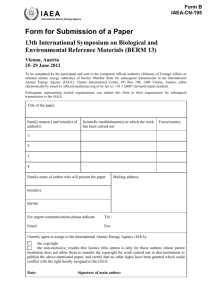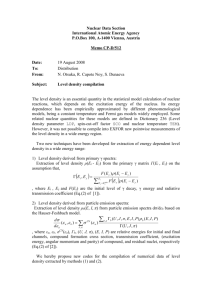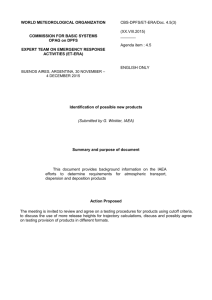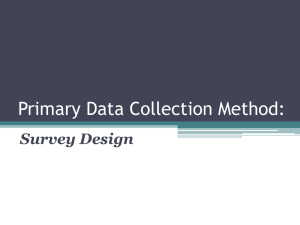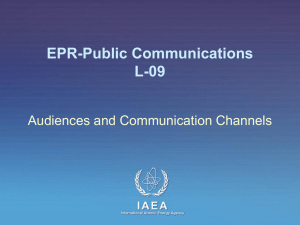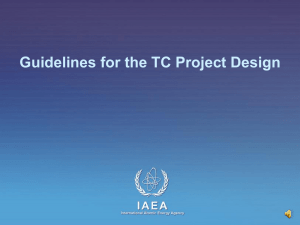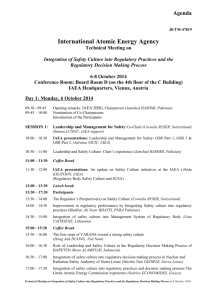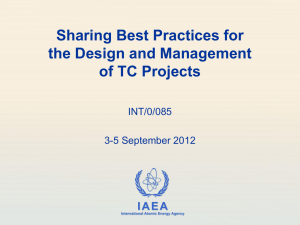The Best Practices (BP) - International Atomic Energy Agency
advertisement
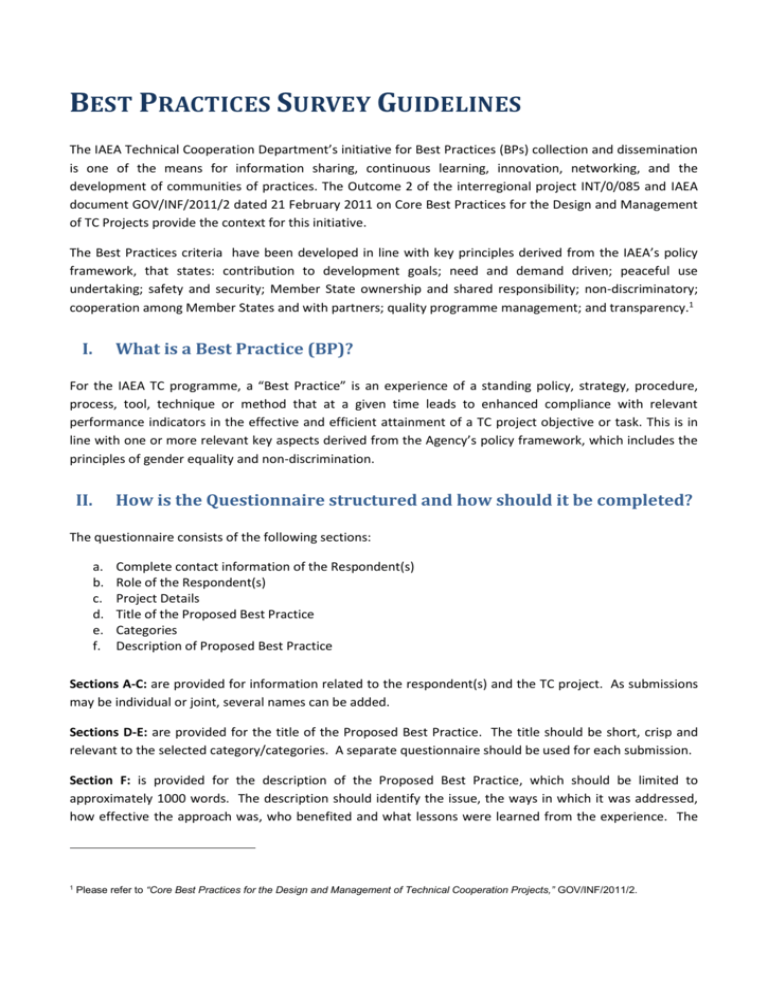
BEST PRACTICES SURVEY GUIDELINES The IAEA Technical Cooperation Department’s initiative for Best Practices (BPs) collection and dissemination is one of the means for information sharing, continuous learning, innovation, networking, and the development of communities of practices. The Outcome 2 of the interregional project INT/0/085 and IAEA document GOV/INF/2011/2 dated 21 February 2011 on Core Best Practices for the Design and Management of TC Projects provide the context for this initiative. The Best Practices criteria have been developed in line with key principles derived from the IAEA’s policy framework, that states: contribution to development goals; need and demand driven; peaceful use undertaking; safety and security; Member State ownership and shared responsibility; non-discriminatory; cooperation among Member States and with partners; quality programme management; and transparency.1 I. What is a Best Practice (BP)? For the IAEA TC programme, a “Best Practice” is an experience of a standing policy, strategy, procedure, process, tool, technique or method that at a given time leads to enhanced compliance with relevant performance indicators in the effective and efficient attainment of a TC project objective or task. This is in line with one or more relevant key aspects derived from the Agency’s policy framework, which includes the principles of gender equality and non-discrimination. II. How is the Questionnaire structured and how should it be completed? The questionnaire consists of the following sections: a. b. c. d. e. f. Complete contact information of the Respondent(s) Role of the Respondent(s) Project Details Title of the Proposed Best Practice Categories Description of Proposed Best Practice Sections A-C: are provided for information related to the respondent(s) and the TC project. As submissions may be individual or joint, several names can be added. Sections D-E: are provided for the title of the Proposed Best Practice. The title should be short, crisp and relevant to the selected category/categories. A separate questionnaire should be used for each submission. Section F: is provided for the description of the Proposed Best Practice, which should be limited to approximately 1000 words. The description should identify the issue, the ways in which it was addressed, how effective the approach was, who benefited and what lessons were learned from the experience. The 1 Please refer to “Core Best Practices for the Design and Management of Technical Cooperation Projects,” GOV/INF/2011/2. prospects for replicability may be added. The respondent(s) may add any other significant information to enable readers to gain a clear understanding of the Proposed Best Practice. Finally, the description should indicate which quality criteria apply to the Proposed Best Practice. Additional references, and quantitative and qualitative evidence including charts and graphs, are allowed as attachments. III. What are the BPs Quality Criteria? BPs quality criteria are derived from the TC Programme Quality Criteria, as follows: 1. Relevance: It is the degree of enhanced compliance to which the programme or project objectives are consistent with end users’ requirements, country needs, and stakeholders’ policies. a. Clear linkages with the Country Programme Framework (CPF) and, in the absence of a CPF, with national development plans/programme and regional strategies; b. Addresses a well-defined gap or priority development need; c. Technical applications that are appropriate and relevant to the state of technical infrastructure in the country, and that have comparative advantage over non-nuclear technologies; d. Alignment with the United Nations Development Assistance Framework (UNDAF) where applicable; 2. Ownership: It is the degree of enhanced compliance demonstrated when Member State or any other stakeholder exercises effective leadership over their programmes and projects. a. Member State (MS)’s commitment to the programme/project reflected by national and regional policies, the allocation of required human, technical and financial resources, and provision of enabling environment b. Planning and preparation of programme/project documentation carried out in using a consultative process in which all programme stakeholders have participated; c. Clear definition of the roles of national institutions and stakeholders expected to participate in the project; d. Counterpart organization has clear mandate to carry out the proposed project; e. Government cost sharing and/or funding from other partners is ensured. 2 3. Sustainability It refers to the degree of enhanced compliance with the continuation of benefits after the completion of a programme/project; probability of continued long term benefits; and resilience to risk of the net benefit over time. a. Downstream mechanisms and modalities are in place to ensure effective linkages between counterparts and end-users; b. Partnerships at the national level are in place; c. Partnerships with UN specialized agencies, international development organizations, non-profit organizations and private sector are identified and partnership proposals are in place wherever possible; d. Partnership with regional agreements and among MSs through regional cooperative agreements are identified and partnership proposals are in place wherever possible; e. Use of national and regional expertise encouraged. Project design incorporates Technical Cooperation among Developing Countries (TCDC) ; f. Project is integrated into the country’s sector/programme planning and budgeting system; g. There is a TC programme/project exit strategy in place, ensuring an effective handover to the counterpart institution; h. Realistic project budget plans are in place; i. Adequate physical and institutional infrastructures as well as human resources are in place to support the project. 4. Efficiency It is the degree of enhanced compliance with performance indicators, addressing the question: “Could the same results have been attained at a lower cost and less time than originally planned?” a. Project implemented within time and budget to achieve outputs outlined in the Logical Framework Matrix (LFM); b. Improvement in productivity of the implementation process according to Logical Framework Matrix (LFM), as measured by the performance indicators; c. A risk management / mitigation plan is in place to address identified major risk areas in case of need. 3 5. Effectiveness It is the degree of enhanced compliance to which programme/project objectives were achieved, or are expected to be achieved, taking into account their relative importance. An aggregate measure of (or judgment on) the merit or worth of an activity, that provides the extent to which it is contributing towards institutional development in the Member State. a. Realistic risks and reasonable assumptions are incorporated into planning and risk mitigation strategies; b. A self-evaluation mechanism is in place to gauge effectiveness during and after the life cycle of the project. There is clear evidence of socio-economic impact as defined by the MS or the counterpart institution; c. Political environment and political will maintained through continued dialogue during changing scenarios such as general elections, government changes or policy shifts. 6. Others: Is the degree of enhanced compliance in any other significant aspect, if not covered above, e.g. field dynamics of projects/programmes, communications and promotion, seeking linkages with other international, regional or national organizations. IV. What is the process? The Best Practices (BP) process consists of the following main steps: BP collection BP selection BP dissemination According to the process, the TCPC/TCQAS will distribute the Survey Questionnaire, Survey Guidelines and related documents to the TC Regional Directors and Technical Departments (TD) Division Directors. The TC Regional Directors will further distribute to (i) PMOs for in-house response and, (ii) NLOs (or Permanent Missions of MSs that do not have NLOs) and Chairs of Cooperative / Regional Agreements for onward release of the survey to stakeholders in the Member States and the IAEA. The TD Division Directors will release the survey to TCLOs and TOs in their respective divisions. The responses to the BP Survey Questionnaire will be submitted to the BP focal point on a dedicated e-mail address as follows: Focal_Point_TC_Best_Practices_Survey@iaea.org. The deadline for respondents for submission is 15 April 2013. An authorized TCBP facilitator will act as a filter point to ensure completeness of information before proceeding to the next stage for review and selection. 4 The Proposed Best Practices will be reviewed by a neutral body, the Best Practices Selection Committee (BPSC) consisting of representatives of TC stakeholders (IAEA Secretariat and Member States). The process will use a two tier mechanism. At the first tier, all submissions will be assessed individually by BPSC members based on the quality criteria indicated by the respondents on the Survey Questionnaire, and rated on a scale of 1 to 5. At the second tier, BPSC members will collectively review a number of highest rated Proposed BPs and will conduct random validation to ensure accuracy and transparency. Both proposed and selected BPs will be organized thematically and across regions. To encourage participation in the sharing of BPs, selected BPs will be disseminated through suitable means of communication. Acronyms used in the Guidelines BP(s) Best Practice(s) BPSC Best Practices Selection Committee CPF Country Programme Framework IAEA International Atomic Energy Agency LFM Logical Framework Matrix MS(s) Member State(s) NLO National Liaison Officer PMO Programme Management Officer SC Selection Committee TC Technical Cooperation TCDC Technical Cooperation among Developing Countries TCLO TCQAS Technical Cooperation Liaison Officer Technical Cooperation Programme Support and Coordination Division Technical Cooperation Quality Assurance Section TD Technical Department TO Technical Officer UN United Nations UNDAF United Nations Development Assistance Framework TCPC 5
